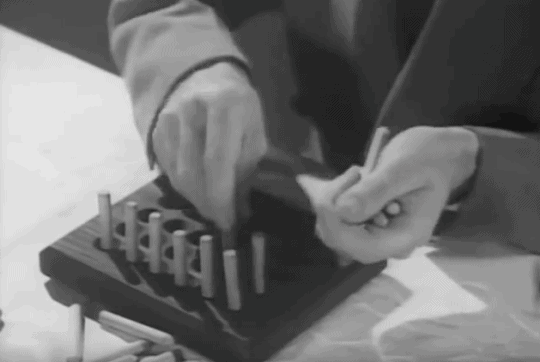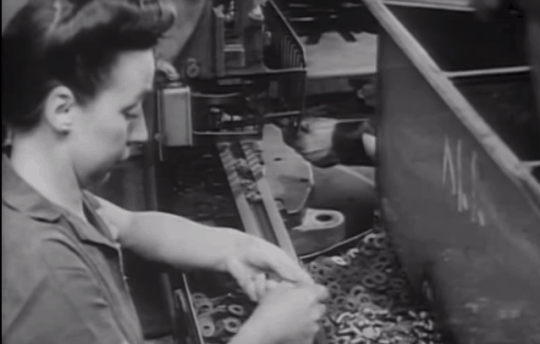 For today's Throwback Thursday, I somehow stumbled across this video on YouTube… it's a video from 1946 that was produced by General Motors, their industrial engineering staff, the General Motors Institute (now Kettering University), and the University of Iowa.
For today's Throwback Thursday, I somehow stumbled across this video on YouTube… it's a video from 1946 that was produced by General Motors, their industrial engineering staff, the General Motors Institute (now Kettering University), and the University of Iowa.
It's a somewhat awkwardly staged dinner party with a colleague and his wife, where the conversation, of course, turns to time and motion study and finding a better way to do things. This was after Bob was done annoying his wife, Marge, with talk about finding a better way to manage the home (and he experimented with ways to set the table).
Marge: “Oh Bob, women can't run a house like a factory.”
Bob: “Why not?
Again, it's 1946… the context is pretty dated, between the family roles and the smoking around the dinner table.
But, it's fun to watch and think about parallels that people might have, today, about Lean.
https://www.youtube.com/watch?v=k9vIhPszb2I
Bob promised to “lay off the shop talk while we're eating.” But, as soon as they were done… there was the shop talk!
Some of the dialogue between Bob and his guest, Dick — apparently they work together.
Dick: No, thanks. How's the new job?
Bob: I like it. It's OK.
Dick: You can have it. I wouldn't trade with you.
Bob: You don't realize what motion study can do, Dick. It works out just like, well, like better machines and better methods.
Times have changed. It's a lot different than it was in the old days. Now we're able to produce more and more stuff with less and less effort on the part of the guys who do the work.
That's what motion study's for. We find out how the machines and tools and the methods of using them should be changed to make it easier for the operator, as I say, it makes your job as a foreman a lot easier.
Dick: Well, it sounds good.
Bob: It's more than sound. I can prove it.
Producing more (assuming it's needed by the customer) with less effort… that sure sounds like Lean.
Making the work easier… that's Lean.
But, one way “times have changed” is that the old days had the efficiency expert, Bob, figuring how people should do their work. In a Lean culture, we involve the operators and employees to make their own work easier. Read my blog post about that change in mindset here.
Dick is skeptical:
Dick: Still doesn't make sense to me. More production equals more work in my language yet you claim it'll make jobs easier and still get results.
Bob: Sure. A man can produce more without working a bit harder.
There's often this concern in hospitals, circa 2015… more patient care means more work or working harder? Not when you improve and redesign work, reducing waste, through Lean.
Since Dick needs some convincing, Bob pulls out a “pin board” training game where your job is to put the pins or pegs into the holes as quickly as possible.

Today, Toyota uses a similar type of peg board in some of their visitor centers, as a sort of test… how quickly can you turn over all of the pegs?
GBMP uses a the same peg board from the GM video and demonstrate “standardized work,” as you can see in this video:
You can buy the peg board and a full training video directly from GBMP.
But back to the video, Bob has Dick try the pins. It took him 40 seconds.
Bob continues to annoy Marge with his suggestions that she's wasteful… that's more of the old “time study man” approach than it is Lean.
Bob: Sure. You girls might like to try it later on. I still say a little motion study around the house would help your housework.
Ann: Listen to the man. Nothing would make housework easy except more things that work when you push a button.
Marge: That's what I keep telling, Bob. He claims there's a lot of waste motion around the house. You should have seen him trying to set this table, studying his motions.
Ann, though, falls into the trap of wanting automation as a way of making work easier…
Bob suggests that Dick try the pin board again, using both hands, and it takes 34 seconds, down from 40.
Dick's wife Ann tries the game, using the same method and it takes her 33 seconds. I'd say the difference between 34 and 33 seconds is “noise” or “common cause variation,” not Ann being faster.

Bob emphasizes that using the same methods gets the same results. “It's not the operator, but the method.” That sounds like modern Lean thinking.
They try another method… 23 seconds! It was the “easiest” method.
Bob then explains a workplace improvement scenario about one employee having trouble keeping up. She had a different method than the other “girls.” He tells another story about making the work easier by reducing wasted motion.

That's Lean… the idea of reducing waste and making work easier. The difference, again, is how you go about it… the expert telling people how to work or engaging and facilitating the employees to figure it out themselves? The Lean approach, with “Kaizen” and a focus on everybody participating in improving, thinking and being creative about their own work, that's how Toyota built upon the class time study methods that we see and hear about in that old-timey video.
[adrotate banner=”141″]
What do you think? Please scroll down (or click) to post a comment. Or please share the post with your thoughts on LinkedIn – and follow me or connect with me there.
Did you like this post? Make sure you don't miss a post or podcast — Subscribe to get notified about posts via email daily or weekly.
Check out my latest book, The Mistakes That Make Us: Cultivating a Culture of Learning and Innovation:




![A LinkedIn Live Event on Visual Workplaces & Lean Management [Recording]](https://www.leanblog.org/wp-content/uploads/2024/12/Lean-LinkedIn-Live-2-238x178.jpg)
![Psychological Safety is the Foundation for Continuous Improvement [Video]](https://www.leanblog.org/wp-content/uploads/2024/09/Lean-Blog-Post-Cover-Image-21-238x178.jpg)




The good old days, when senior management saw value in industrial engineering. Ralph Barnes was a major IE figure back then. In the early 1990s, the company I worked for laid of hundreds of IEs. The few that survived did not want anyone to know that they were IEs. Sad. Soon after began the hiring of legions of finance and accounting people who would soon run the business via spreadsheets… specialists in “go see” the computer screen.
I found the GM video a while ago and it inspired me to build my own (poorly constructed) pegboard for my Lean training courses. It’s a fun introductory exercise with a group that introduces the concept of waste (motion), as well as the importance of experimentation and standard work.
After the exercise and lots of healthy debate on the best method to insert the pegs, I ask the class if they want to watch the GM video. They always say yes. Of course I always preface the video with a warning that it was filmed in a different era and may be politically incorrect. :-)
Mark – Great blog! I hadn’t seen the video before. It certainly reinforces the fact that the core thinking that’s at the heart of Lean manufacturing has been around for a long time. And, of course, much of this thinking predates this video. Henry Ford, at his Highland Park plant in the teens of the last century, was putting Lean thinking to work. In fact, Lean is just plain common sense. Unhappily, common sense is not to be found in many work environments.
Henry Ford might have been thinking in terms of efficiency and improvement, but I think one characteristic that separates Ford-ism from Lean/TPS is the involvement of everybody in continuous improvement…
I actually think a lot about Lean is quite unintuitive or uncommon, such as the idea that smaller batches can improve efficiency and that the boss doesn’t have all of the answers.
https://www.leanblog.org/2014/04/lean-is-common-sense-obviouslylean/
Mark, you are right…many aspects of Lean are counter-intuitive, esp. one piece flow. I use Ron Pereira’s envelope exercise to teach one piece flow and it is very eye-opening for most of the participants.
The lack of PPE in the factory is interesting. I see that a lot in old factory photos and films.
My favorite quote by Dick: “I didn’t realize I was doing a motion study when I changed that worker’s method.” Their concept of motion-study is Lean friendly; how they implemented (tell versus train) isn’t.
This is a nice example of focusing on the value-add portion of the value stream. One ah-ha moment I had as an IE learning Lean was the leverage possible by focusing on the other 98% of the value stream.
Yes, “tell versus train” or “boss versus engage” or “boss versus coach” is a good way of illustrating the difference between old-fashioned time study and Lean. Are you being studied or are you studying your own work?
Isn’t the best strategy a little bit of both? Engineers working closely with front-line workers to drive improvements and develop best methods?
Yes, working together. It’s not the old approach of all top-down or all engineer driven. But it’s also not a complete delegation to the front line staff.